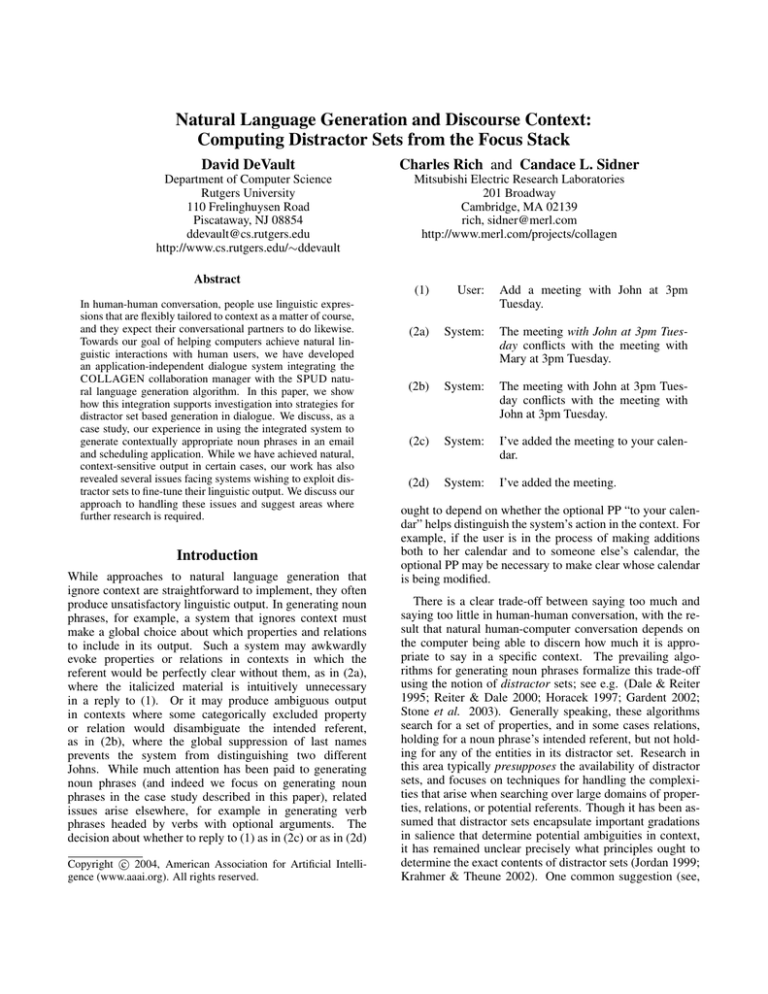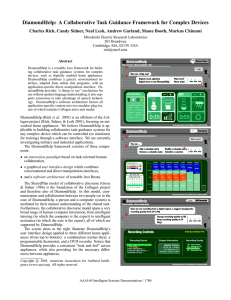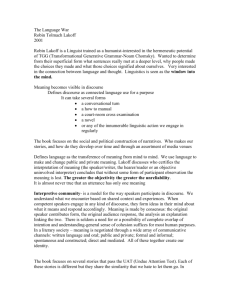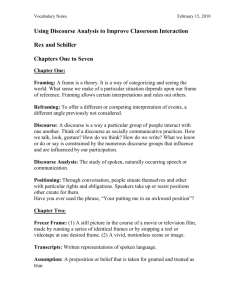
Natural Language Generation and Discourse Context:
Computing Distractor Sets from the Focus Stack
David DeVault
Department of Computer Science
Rutgers University
110 Frelinghuysen Road
Piscataway, NJ 08854
ddevault@cs.rutgers.edu
http://www.cs.rutgers.edu/∼ddevault
Abstract
In human-human conversation, people use linguistic expressions that are flexibly tailored to context as a matter of course,
and they expect their conversational partners to do likewise.
Towards our goal of helping computers achieve natural linguistic interactions with human users, we have developed
an application-independent dialogue system integrating the
COLLAGEN collaboration manager with the SPUD natural language generation algorithm. In this paper, we show
how this integration supports investigation into strategies for
distractor set based generation in dialogue. We discuss, as a
case study, our experience in using the integrated system to
generate contextually appropriate noun phrases in an email
and scheduling application. While we have achieved natural,
context-sensitive output in certain cases, our work has also
revealed several issues facing systems wishing to exploit distractor sets to fine-tune their linguistic output. We discuss our
approach to handling these issues and suggest areas where
further research is required.
Introduction
While approaches to natural language generation that
ignore context are straightforward to implement, they often
produce unsatisfactory linguistic output. In generating noun
phrases, for example, a system that ignores context must
make a global choice about which properties and relations
to include in its output. Such a system may awkwardly
evoke properties or relations in contexts in which the
referent would be perfectly clear without them, as in (2a),
where the italicized material is intuitively unnecessary
in a reply to (1). Or it may produce ambiguous output
in contexts where some categorically excluded property
or relation would disambiguate the intended referent,
as in (2b), where the global suppression of last names
prevents the system from distinguishing two different
Johns. While much attention has been paid to generating
noun phrases (and indeed we focus on generating noun
phrases in the case study described in this paper), related
issues arise elsewhere, for example in generating verb
phrases headed by verbs with optional arguments. The
decision about whether to reply to (1) as in (2c) or as in (2d)
c 2004, American Association for Artificial IntelliCopyright gence (www.aaai.org). All rights reserved.
Charles Rich and Candace L. Sidner
Mitsubishi Electric Research Laboratories
201 Broadway
Cambridge, MA 02139
rich, sidner@merl.com
http://www.merl.com/projects/collagen
(1)
User:
Add a meeting with John at 3pm
Tuesday.
(2a)
System:
The meeting with John at 3pm Tuesday conflicts with the meeting with
Mary at 3pm Tuesday.
(2b)
System:
The meeting with John at 3pm Tuesday conflicts with the meeting with
John at 3pm Tuesday.
(2c)
System:
I’ve added the meeting to your calendar.
(2d)
System:
I’ve added the meeting.
ought to depend on whether the optional PP “to your calendar” helps distinguish the system’s action in the context. For
example, if the user is in the process of making additions
both to her calendar and to someone else’s calendar, the
optional PP may be necessary to make clear whose calendar
is being modified.
There is a clear trade-off between saying too much and
saying too little in human-human conversation, with the result that natural human-computer conversation depends on
the computer being able to discern how much it is appropriate to say in a specific context. The prevailing algorithms for generating noun phrases formalize this trade-off
using the notion of distractor sets; see e.g. (Dale & Reiter
1995; Reiter & Dale 2000; Horacek 1997; Gardent 2002;
Stone et al. 2003). Generally speaking, these algorithms
search for a set of properties, and in some cases relations,
holding for a noun phrase’s intended referent, but not holding for any of the entities in its distractor set. Research in
this area typically presupposes the availability of distractor
sets, and focuses on techniques for handling the complexities that arise when searching over large domains of properties, relations, or potential referents. Though it has been assumed that distractor sets encapsulate important gradations
in salience that determine potential ambiguities in context,
it has remained unclear precisely what principles ought to
determine the exact contents of distractor sets (Jordan 1999;
Krahmer & Theune 2002). One common suggestion (see,
e.g. (Horacek 1997; Reiter & Dale 2000)), which we pursue
in this paper, is that the rich hierarchical model of attention in a discourse context that was introduced in (Grosz &
Sidner 1986) may capture the relevant information for constructing distractor sets.
In the next section, we describe a new dialogue system we
have developed integrating COLLAGEN, an architecture
for building collaborative agents based on a theory of discourse structure which began with (Grosz & Sidner 1986),
with SPUD, a sophisticated, distractor set based natural language generation algorithm. Then we discuss, as a case
study, our experience in using the integrated system to generate contextually appropriate noun phrases in an email and
scheduling application. In the final section, we discuss our
approach to handling several issues we encountered in constructing appropriate distractor sets, and suggest areas where
further research is required.
System description
COLLAGEN
COLLAGEN (for COLLaborative AGENt) (Rich, Sidner,
& Lesh 2001) is a practical architecture for building dialogue systems and an implementation of a theory of collaborative discourse developed over a number of years (Grosz &
Sidner 1986; 1990; Grosz & Kraus 1996; Lochbaum 1998).
In order to model the intentional structure in a humancomputer conversation, COLLAGEN applications include
a task model consisting of top-level goals for the interaction
and a library of recipes which decompose these goals into
subgoals, recursively. Each discourse purpose is represented
as a shared goal to be achieved collaboratively by the human
user and the COLLAGEN agent. Goals can be achieved
by utterances, by direct action, or by carrying out recipes;
in the latter case, hierarchical discourse structure emerges.
COLLAGEN uses recipe-based plan-recognition to interpret user utterances as contributions to open goals. System
responses are generated using the same recipe library and
some simple planning heuristics.
Importantly for generation, COLLAGEN enters each entity that figures in a user or system utterance into a hierarchical analysis of the attentional structure of the discourse,
implemented as a stack of focus spaces. The placement of
an entity in the focus stack is determined by how the utterance containing that entity fits into the current overall intentional structure of the discourse. The introduction of new
discourse goals results in new focus spaces being pushed
onto the stack, and the completion of discourse goals results
in old focus spaces being popped, as in (Grosz & Sidner
1986). Entities that have been featured in utterances serving
more immediate open goals are present in focus spaces near
the top of the stack, and are thus, according to the theory,
comparatively more salient. The end result is that COLLAGEN applications have access to a fine-grained model of
the comparative saliences of entities at each point in a conversation; i.e., they have access to precisely what is needed
to drive models of generation presupposing distractor sets.
Some examples of focus stacks generated by COLLAGEN
are illustrated in Figure 3 and discussed below.
Previous research using the COLLAGEN framework
has been focused on appropriately modeling the intentional
structure of discourse rather than on exploiting the focus
stack for context-sensitive generation. In the past, COLLAGEN agents have thus employed a context-independent,
template-based generation scheme.
SPUD
SPUD (for Sentence Planning Using Description) (Stone et
al. 2003) is a general purpose, sophisticated natural language generation algorithm which we see as a promising
approach to achieving much of the flexibility and contextsensitivity human users expect in natural human-computer
dialogue. SPUD is general purpose in the sense that it is
designed to generate complete utterances—it subsumes the
generation of definite noun phrases as a special case instead
of treating them as the central concern, as in work such as
(Dale & Reiter 1995). For example, while SPUD could be
used to choose whether to include the italicized material in
generating the first noun phrase of (2a), it could also be used
to decide whether to include the optional PP in generating
a complete sentential utterance such as (2c) or (2d). It is
sophisticated in that it works in a rich space of candidate utterances in response to a rich problem specification. We provide only a high-level summary of the algorithm here, and
refer the interested reader to (Stone et al. 2003) for details.
A
SPUD
generation
problem
consists
of:
(3a)
(3b)
(3c)
(3d)
(3e)
(3f)
(3g)
the syntactic category of the root node for the generated utterance,
a set of contributions to the discourse state to be
made by the generated utterance,
the intended interpretation of any discourse
anaphors introduced by the root node,
any syntactic feature values imposed from above
on the root node,
a lexicalized tree adjoining grammar (LTAG) in
which lexical entries are decorated with semantic
constraints,
a knowledge interface that can answer semantic
queries, and
a mechanism for retrieving context-sensitive distractor sets for arbitrary individuals.
Essentially, a SPUD problem dictates what kind of utterance is required (3a), what the utterance should accomplish (3b), whether the root node must refer to any particular individual (3c),1 whether any syntactic constraints such
as case or number bear on the utterance (3d), what linguistic resources are available (3e), what the relevant facts are
(3f), and what the relative saliences of various individuals
are (3g).
The linguistic resources of (3e) record the semantic effects of using individual lexical entries as sets of constraints
defined over discourse anaphor variables. The knowledge
1
For example, if SPUD is used to generate a definite noun
phrase, the intended referent can be specified here. This is exactly
what we do in the case study described later in this paper.
interface of (3f) is expected to provide exhaustive sets of
solutions to these semantic constraints during generation.
There are two types of constraints, and two associated types
of knowledge interface queries.2 Presuppositions record
properties and relations that a speaker can presuppose as
known by a hearer. For example the lexical entry for the
noun meeting may have {meeting(X)} as its presupposition, where X is a discourse anaphor corresponding to the
referent of the noun phrase headed by the word meeting.3
The knowledge interface solves presupposed constraints of
the form meeting(X) by providing interpretations for X as
domain individuals that the hearer can be assumed to know
are meetings. Assertions record the contributions to the discourse state made by particular lexical items. For example
the lexical entry for the verb sings might assert {sings(X)},
where X is the subject of the verb phrase headed by the
word sings. The knowledge interface solves assertion constraints of the form sings(X) by providing interpretations
for X such that X can be asserted to sing. Ordinarily a dialogue system will allow the assertion of some fact only if it is
believed to be true, for example. Providing this knowledge
interface in general constitutes the difficult problem of translating between the semantics of general linguistic words and
specific domain predicates and individuals; see, e.g., (Stone
2003) for an approach consonant with the SPUD framework.
Given a problem specification as in (3a-g), SPUD construes generation as a search problem defined over a space
of communicative intents. A communicative intent is a
data structure recording all the information SPUD uses to
gauge its progress, including a partially saturated syntactic tree structure, an intended interpretation for any discourse anaphors in the provisional utterance, the supported
interpretations for the discourse anaphors, and which of
the desired contributions the provisional utterance achieves.
SPUD employs head-first greedy search, with search states
expanded by syntactic operations that combine new lexical
entries into the provisional utterance. Candidate next states
are evaluated by a greedy search heuristic that includes preferences to achieve more desired contributions, resolve ambiguities, and saturate the syntactic tree structure, inter alia. If
generation is successful, SPUD’s product is a communicative intent containing a fully saturated syntactic tree structure and recording the intended (and, since generation was
successful, distinguished) interpretations of all the discourse
anaphors in the utterance.
An integrated dialogue system
The overall architecture of our integrated dialogue system
is illustrated in Figure 1. The essential issue in exploiting
SPUD in COLLAGEN dialogue systems is determining
how to formulate appropriate SPUD generation problems,
as in (3a-g), in particular dialogue situations. The appro2
Here we discuss presuppositions and assertions, but the full
SPUD system additionally accommodates pragmatic constraints
as well. See (Stone et al. 2003) for details.
3
This example assumes the lexical entry can only figure in a
definite noun phrase.
priate values for (3a-d) vary according to whether SPUD is
used to generate an NP or a complete sentence. For generating distinguishing noun phrases, (3a) is NP, (3b) is generally
empty, (3c) is the intended referent, and (3d) depends on
the context in which the NP is to be embedded. We intend
to generate complete sentences with SPUD eventually, in
which case (3a) is S, (3b) depends on the intention motivating the utterance, (3c) is empty unless sentences are treated
as referential, and (3d) is probably empty.
Developing a SPUD grammar for (3e) is straightforward,
if somewhat time intensive. In COLLAGEN applications,
where a static mapping between linguistic and domain properties is possible, specifying a knowledge interface for (3f) is
relatively straightforward. The only complexity is that information about whether properties and relations hold for various individuals tends to be distributed among a diffuse set
of objects designed for the particular COLLAGEN application, so that providing a knowledge interface requires manual specification of the conversion between the constraintbased representation utilized for linguistic semantics and actual application object queries.
In our experience, the most substantive issue in achieving
this integration lies in the construction of distractor sets for
generation. While COLLAGEN associates discourse states
with a focus stack (and therefore a partial order on object
salience), this model has not been extensively explored for
generation purposes, and how to exploit it to construct distractor sets that lead to good generation results is not well
understood. As an initial strategy, we have adopted the simple strategy of searching down the focus stack, starting at
the most salient focus space, accumulating all encountered
individuals as distractors until we reach the first focus space
containing the intended referent. Thus the distractor set for a
target individual includes all individuals mentioned in utterances supporting goals at least as immediate as the goal that
motivated the most recent mention of the target individual.
The algorithm is given in Figure 2. Note that the algorithm
identifies individuals not yet in COLLAGEN’s focus stack
as a special case. We return to the issue of first mentions of
new individuals below.
A case study: an email and scheduling
application
As a case study, we used our new integrated system to extend a preexisting COLLAGEN-based email and scheduling application (Gruen et al. 1999). Though we believe our
system will eventually generate full sentential utterances, as
a first step, we investigated the generation of referring noun
phrases, which were then integrated into the output of COLLAGEN’s template-based generation system to make full
sentences.
The grammar we developed includes six simple lexical
entries, the, message, meeting, from, you, and it. It also includes several quasi-lexical entries that allow us to generate
references to individuals from several open ended classes,
including dates, meeting topics, and email addresses, without actually developing a fully lexicalized grammar sufficient for covering these domains. We mapped presupposed
COLLAGEN
USER
AGENT
Utterances
DISCOURSE
EVENT
INTERPRETER
User and agent
utterances and
actions
DISCOURSE
STATE
Utterances
Actions
Actions
Agent
utterances and actions
DISCOURSE
RESPONSE
GENERATOR
Communicative
intents
APPLICATION
Domain facts
TASK
MODEL
KNOWLEDGE
INTERFACE
Semantic
facts
Distractor
sets
Generation
problems
SPUD
Figure 1: The architecture of our integrated system.
constraint queries onto application object queries in a simple
knowledge interface, and generated distractor sets according
to the algorithm of Figure 2. We then posed SPUD distinguishing noun phrase generation problems, as described
above.
We describe our results in the context of a typical interaction with the email and scheduling application. The interaction consists of 55 dialogue events, including utterances and
actions by both the user and the agent. Figure 3 illustrates
some of the results. For example, in utterance 31, our integrated system refers to msg2 as “the message” rather than
“the message from you” because msg2 is the most salient
individual in the current discourse state (and hence has no
distractors). Indeed, SPUD would have generated “it” in
this case, but we explicitly forbid a pronoun here since pronouns integrate poorly with the template “Please fill in the
cc field of <SPUD-output>”, which we used in integrating SPUD’s output with COLLAGEN’s broader templatebased generation system. Note that if SPUD had been used
to generate a referring noun phrase for msg1 at this point,
“the message from John” would have been generated, rather
than “the message”, because msg1 has msg2, which is also
a message, as a distractor. In utterance 52, our integrated
system refers to mtg1 as “it” instead of awkwardly reiterating the meeting date and topic as recently specified by
the user in utterance 48. In fact, the intervening utterances,
which have been left out of the figure, all concern mtg1 as
well; the verbose output of COLLAGEN’s template-based
generation system underscores the awkward redundancy that
can occur when context does not inform generation choices.
Overall, in the interaction described here, our integrated
system uttered noun phrases to refer to individuals already
present in the discourse state 10 times. In 7 of these 10
times, the system produced shorter noun phrases, including
four uses of the pronoun it. The overall economy was a sav-
To compute a distractor set Dr for
individual r:
Initialize Dr to ∅.
Search over focus spaces F , from
most to least salient
Search over individuals x in F
If x 6= r add x to Dr .
If x ∈ F return Dr .
Fail (first mention).
GRAMMAR
Figure 2: A straightforward algorithm
for deriving distractor sets from the current COLLAGEN attentional state.
ings of 2 words in 3 cases, 3 words in 1 case, 8 words in 1
case, and 9 words in 2 cases. In the remaining 3 cases, the
output of COLLAGEN’s template-based generation system
was already as economical as contextually possible.
To assess the improvement quantitatively would require a
time-intensive exploration of a large space of possible user
behavior and resulting interactions, which is methodologically prohibitive. Nevertheless, we have found the results
presented here to be representative of results that occur in
other interactions with this application. While we discuss
some difficulties we encountered in the next section, we
have generally found that our integrated system produces an
appropriate gradient of unambiguous noun phrases. We take
our experience to show that generic applications can exploit
this architecture to generate hierarchical salience gradients
that can be used to better tune linguistic output to context.
As such it constitutes a promising venue for further research
into context-sensitive generation for dialogue systems.
Discussion and further work
One issue brought out by our case study concerns how generated utterances place the individuals they feature into a
discourse’s evolving attentional structure, where they can
serve as candidates for subsequent reference and as distractors in subsequent generation. A naive approach to focus
stack update, which we initially took, is to simply read the
newly salient individuals directly off of the domain representations that were used to drive generation. For example, in our email and scheduling application, upon generating and uttering a noun phrase designed to refer to msg1,
we would simply add msg1 to the top level focus space.
However, this approach is inadequate because, in general,
additional individuals can be evoked in an utterance as a
consequence of how the generated utterance “presents” the
intended referent to the user. A simple example is the gen-
Utterance
#
Focus stack
Intended referent
Distractors
Utterance
24
msg1(John,Debra)
msg1
n/a
(user)
25
msg1(John,Debra)
msg2.to
n/a
(first mention)
31
msg2(user,Steve Kranz)
msg1(John,Debra)
msg2
{}
mtg1
n/a
(user)
mtg1
{}
USER: “Please forward the
message from John.”
COLLAGEN: “Who is the
recipient?”
SPUD: n/a (first mention)
COLLAGEN: “Please fill in
the cc field of the message
from you.”
SPUD: “Please fill in the cc
field of the message.”
USER: “Let’s schedule the
meeting at May 5, 1999 10:00
AM with Brian.”
COLLAGEN: “I’m going to
add the meeting at May 5,
1999 10:00 AM with Brian to
the calendar.”
SPUD: “I’m going to add it
to the calendar.”
48
52
msg1(John,Debra)
mtg1(with Brian,May 5...)
msg1(John,Debra)
Figure 3: Examples of noun phrase generation using two versions of our email and scheduling application. The italicized noun
phrases in utterances 25, 31, and 52 were generated by the original template-based generation algorithm (marked COLLAGEN:) and by our integrated system (marked SPUD:). The user utterances, numbered 24 and 48, are included here to provide
context for the generated utterances. msg2.to in utterance 25 is the unknown recipient of the forward of msg1 requested by
the user in utterance 24. msg2, the actual forward, has entered into the focus stack explicitly by utterance 31. Some detail has
been omitted for clarity.
eration of “the message from John” to refer to msg1, which
makes not only msg1 but also the domain individual representing John more salient.
A more interesting example from our application arises
in utterance 31 of Figure 3. Our application represents the
action of filling in the cc field of an email as an action
fillCCField taking a single message argument. When
an action like fillCCField(msg2) is presented linguistically, for example as in
(4) Please fill in the cc field of the message,
the linguistic expression of the single domain action
fillCCField is split between the verb “fill” and a contribution “the cc field of [N P ]” to its noun phrase complement. Notice that a human user, upon hearing (4), will
model two new individuals as more salient and available for
subsequent reference: both the message (msg2) and its cc
field (msg2.cc). However the naive focus stack update
strategy might counsel that only msg2 should be added to
the top focus space. The consequence for generation is that
a system employing this naive approach to focus stack update may compute subsequent distractor sets that fail to capture ambiguities the user will perceive. For example, suppose the user fills in the cc field of msg2 in response to a
system utterance of (4), and then asks the system, “What
next?” The system, attempting to express that (the body of)
message msg2 needs to be completed next, and believing
that msg2 has no distractors, might utter
(5) Finish it.
Yet the user would very likely perceive (5) as ambiguous
between an instruction to finish the message body and an
instruction to finish the somehow still unfinished cc field.
The right general moral here seems to be that focus state
update must result from a model of which domain individuals users (hearers) take as having been rendered more salient
by an utterance, rather than from a simple record of what
domain individuals the dialogue system intended to express.
Developing such a model can be difficult in systems that integrate template-based output with context-sensitive output.
In our application, we could have assumed that users take
all noun phrases as bringing their referents into salience, and
avoided this problem. This would have been difficult however since the output of COLLAGEN’s template-based generation, into which we were embedding SPUD’s generated
descriptions of action arguments, lacks any explicit syntactic
information. This strategy would also necessitate the manual
specification of the referents of all the extra noun phrases.
Instead, we accepted that our focus state would incorrectly
model ambiguities from time to time, and attempted to mitigate the consequences by adopting a heuristic of preferring
more specific linguistic output in certain situations. In particular, we explicitly ruled out pronouns in problematic situations (which were identified manually). The use of other
noun phrases, with their generally more restrictive semantics, cuts down on the number of possible unanticipated ambiguities. For example, while “it” might be unexpectedly
ambiguous between msg2 and msg2.cc after an utterance
of (4), “the message” is less likely to be. This is clearly
not a complete solution, since “the message” might itself be
ambiguous due to some other unexpected ambiguity.
A second issue that arose in our case study concerns first
mentions of new individuals. It is often suggested (see (Reiter & Dale 2000), for example), that the generation of referring expressions in dialogue can be understood as falling
fundamentally into two types. In initial references or first
mentions, the intended referent has not yet appeared in the
discourse, and what is said is assumed to depend entirely on
application-specific goals. Properties and relations are included in first mentions if they are expected to be relevant
in subsequent discourse. In subsequent references, on the
other hand, what is said depends essentially on what has to
be said in order to distinguish the intended referent; this is
the problem that distractor set based generation is geared toward solving.
However, in our case study, we often encountered circumstances, such as that in utterance 25 of Figure 3, where intuitively what is desired is an initial reference, but where there
are no application-specific goals apart from successful reference, and where, as is the typical case with subsequent reference, there is a preference for only saying what has to be said
in order to distinguish the intended referent.4 In utterance
25, for example, “the recipient” seems appropriate because
the forwarding action requested in utterance 24 is so prominent. Yet we can easily imagine other discourse scenarios
where an initial reference at a different level of detail would
be appropriate. For example, if the user had said “Please
forward the message from John and the file from Robert,”
the italicized NP of (6a) would intuitively be an appropriate
initial reference. If the user had said “Please forward the
message from John and the message from Robert,” the more
elaborate initial reference of (6b) might be necessary.
(6a) Who is the recipient of the message?
(6b) Who is the recipient of the message from John?
Thus, there appears to be a “purely referential” type of
initial reference in which a contextually appropriate initial
reference is desired, but in which application-specific goals
do not motivate a particular detailed choice for the actual
description. In our email and scheduling application, such
contextually appropriate initial reference is desirable but not
possible. Since individuals do not enter into COLLAGEN’s
focus stack until they have been mentioned, distractor sets
are not available in cases of initial reference. Consequently,
in our system, COLLAGEN’s template-based generation
mechanism, rather than SPUD, handles initial reference.
The intuitive naturalness of such contextually appropriate
initial reference in discourse suggests a difficult problem:
how can we generate noun phrases to an appropriate level
of detail when distractor sets cannot be computed from the
referent’s current position in the focus stack? A general solution seems to depend on a deeper model of interpretation
ambiguities than is available in COLLAGEN’s focus stack,
one in which an individual is salient not only according to its
4
Of course, some application-specific goal motivates any given
entire utterance — otherwise, presumably, there would be no point
in saying anything. For utterance 25, the utterance-level goal is
to propose that the user identify the recipient of the forward. But
such a broad goal may not motivate any particular choice for an
embedded initial reference.
place in the intentional structure of the preceding discourse,
but also according to its place in the strategy a hearer will
employ in interpreting references to new individuals. Formalizing a generation strategy for contextually appropriate
initial reference remains an interesting problem for future
work.
References
Dale, R., and Reiter, E. 1995. Computational interpretations of the Gricean maxims in the generation of referring
expressions. Cognitive Science 19(2):233–263.
Gardent, C. 2002. Generating minimal definite descriptions. In Proceedings of the 40th Annual Meeting of the
Association for Computational Linguistics (ACL), 96–103.
Grosz, B. J., and Kraus, S. 1996. Collaborative plans for
complex group action. Artificial Intelligence 86(2):269–
357.
Grosz, B. J., and Sidner, C. L. 1986. Attention, intentions,
and the structure of discourse. Computational Linguistics
12(3):175–204.
Grosz, B. J., and Sidner, C. L. 1990. Plans for discourse.
In Cohen, P. R.; Morgan, J.; and Pollack, M. E., eds., Intentions in Communication. MIT. 417–444.
Gruen, D.; Sidner, C.; Boettner, C.; and Rich, C. 1999. A
collaborative assistant for email. In Proceedings of Human
Factors in Computing Systems, Extended Abstracts, 196–
197.
Horacek, H. 1997. An algorithm for generating referential
descriptions with flexible interfaces. In Proceedings of the
35th Annual Meeting of the Association for Computational
Linguistics (ACL), 206–213.
Jordan, P. W. 1999. An empirical study of the communicative goals impacting nominal expressions. In Proceedings
of the ESSLLI workshop on The Generation of Nominal Expressions.
Krahmer, E., and Theune, M. 2002. Efficient contextsensitive generation of referring expressions. In van
Deemter, K., and Kibble, R., eds., Information Sharing:
Reference and Presupposition in Language Generation and
Interpretation. CSLI Publications. 223–264.
Lochbaum, K. E. 1998. A collaborative planning
model of intentional structure. Computational Linguistics
24(4):525–572.
Reiter, E., and Dale, R. 2000. Building Natural Language
Generation Systems. Cambridge University Press.
Rich, C.; Sidner, C. L.; and Lesh, N. 2001. COLLAGEN: Applying collaborative discourse theory to humancomputer interaction. Artificial Intelligence Magazine
22(4):15–25.
Stone, M.; Doran, C.; Webber, B.; Bleam, T.; and Palmer,
M. 2003. Microplanning with communicative intentions:
the SPUD system. Computational Intelligence 19(4):314–
381.
Stone, M. 2003. Knowledge representation for language
engineering. In Farghaly, A., ed., Handbook for Language
Engineers. CSLI Publications. 299–366.









